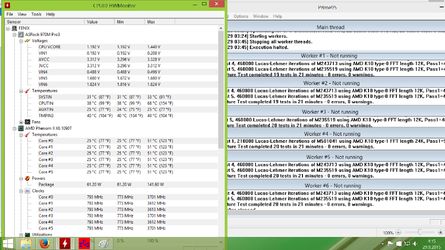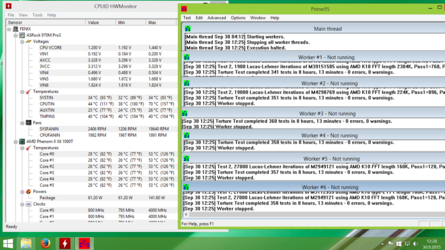- Joined
- Sep 28, 2015
First things first, this is what I'm working with:
CPU: AMD Phenom II X6 1090T BE
GPU: NVidia GTX 650
MB: ASRock 970M Pro3
RAM: 2 x 8 GB Kinston HyperX Fury Black DDR3 (official numbers 1600 MHz CL10, stock values 1333 MHz CL9 due to Phenom II)
PSU: Cooler Master V650S
HDD: Samsung 850 EVO SSD 250 GB
Case: BitFenix Prodigy M
CPU Cooler: Arctic Cooling Freezer A11
Fans: 2 x BitFenix Spectre 120 mm
OS: Windows 8.1 64-bit & Linux Mint 17.2 Cinnamon 64-bit
Although I've been using computers since 1986 this is the first computer I've tried to overclock, partially because this is my first own desktop computer since the early 00's. This particular machine I obtained a couple of months ago. I was on a pretty tight budget, but luckily a couple of friends wanted to get rid of some parts at a very reasonable price and so I ended up with the Phenom II and GTX 650. Of these two only the GPU could be considered a bottleneck for my needs, and even if I went out and got a GTX 980 I wouldn't have to worry about the CPU wasting its talents. So, there was really no need for me to try overclocking. However, it was something that I had wanted to try for a long time and since a modern BIOS/UEFI makes it very easy, I decided give it a go. However, there were some limitations from the start:
-I have a mini ATX case, which means there's less space for a proper CPU cooler.
-The current CPU cooler is no more efficient than the stock cooler, only quieter.
-Running Prime95 in max heat mode for about 20 minutes brings my socket temp to 68 degrees Celcius (see picture) even at stock speeds (70, if the room gets warm from running Prime95).
So, I read some of the articles written about overclocking a Phenom II and decided to follow these basic principles:
-Keep the voltages at stock values in order to keep temps down.
-Concentrate on overclocking the Turbo Core mode instead of all six cores.
-Don't get too greedy.
The justification for the second principle is as follows: The Turbo Core mode has soft limits (in other words doesn't switch off immediately when a fourth core is needed) and most programs do not stress all six cores. Furthermore, the voltage is higher in Turbo Core mode than in normal mode, which means that there's a good chance of braking 4 GHz just by increasing the multiplier. The Turbo Core mode also keeps temps down, since only some of the cores will be running under full load. In theory I should be able to reap higher rewards in everyday usage while at the same time keeping temperatures well below 50 C.
Before I registered onto this forum, I had already overclocked my computer as follows:
CPU: 3,2 GHz / 3,6 GHz (Turbo) -> 3,5 GHz / 4,1 GHz (Turbo)
RAM: 1333 MHz CL9 (9-9-9-25) -> 1600 MHz CL9 (9-9-9-25)
CPU-NB: 2000 MHz -> 2200 MHz
HT link: 2000 MHz -> 2200 MHz (I read somewhere that Phenom II's prefer both running at the same clock frequency)
The system could run Prime95 for an hour or two without issues, but then I suffered a couple of crashes while running GPU tests with Phoronix test suite (on Linux) and a crash or two while running 3DMark 11, so I started so suspect something was wrong. Also, I noticed my socket temperature was going up to 71,5 C, which is less than optimal. Now I'm starting from scratch and trying to do some more benchmarking and temperature checking at each step. I'll follow the following procedure and report my findings as I go along (and whenever I have the time to write):
1. OC RAM to 1600 MHz CL9 (9-9-9-25)
2. OC CPU-NB/HT to 2200 MHz
3. Take CPU-NB/HT back to 2000 MHz, OC CPU to 3,2 GHz/4,1 GHz (Turbo)
4. Bring CPU-NB/HT back up to 2200 MHz
Finally and if no problems arise before finishing this set, I'll test the system by running Prime95 overnight.
Wish me luck!
CPU: AMD Phenom II X6 1090T BE
GPU: NVidia GTX 650
MB: ASRock 970M Pro3
RAM: 2 x 8 GB Kinston HyperX Fury Black DDR3 (official numbers 1600 MHz CL10, stock values 1333 MHz CL9 due to Phenom II)
PSU: Cooler Master V650S
HDD: Samsung 850 EVO SSD 250 GB
Case: BitFenix Prodigy M
CPU Cooler: Arctic Cooling Freezer A11
Fans: 2 x BitFenix Spectre 120 mm
OS: Windows 8.1 64-bit & Linux Mint 17.2 Cinnamon 64-bit
Although I've been using computers since 1986 this is the first computer I've tried to overclock, partially because this is my first own desktop computer since the early 00's. This particular machine I obtained a couple of months ago. I was on a pretty tight budget, but luckily a couple of friends wanted to get rid of some parts at a very reasonable price and so I ended up with the Phenom II and GTX 650. Of these two only the GPU could be considered a bottleneck for my needs, and even if I went out and got a GTX 980 I wouldn't have to worry about the CPU wasting its talents. So, there was really no need for me to try overclocking. However, it was something that I had wanted to try for a long time and since a modern BIOS/UEFI makes it very easy, I decided give it a go. However, there were some limitations from the start:
-I have a mini ATX case, which means there's less space for a proper CPU cooler.
-The current CPU cooler is no more efficient than the stock cooler, only quieter.
-Running Prime95 in max heat mode for about 20 minutes brings my socket temp to 68 degrees Celcius (see picture) even at stock speeds (70, if the room gets warm from running Prime95).
So, I read some of the articles written about overclocking a Phenom II and decided to follow these basic principles:
-Keep the voltages at stock values in order to keep temps down.
-Concentrate on overclocking the Turbo Core mode instead of all six cores.
-Don't get too greedy.
The justification for the second principle is as follows: The Turbo Core mode has soft limits (in other words doesn't switch off immediately when a fourth core is needed) and most programs do not stress all six cores. Furthermore, the voltage is higher in Turbo Core mode than in normal mode, which means that there's a good chance of braking 4 GHz just by increasing the multiplier. The Turbo Core mode also keeps temps down, since only some of the cores will be running under full load. In theory I should be able to reap higher rewards in everyday usage while at the same time keeping temperatures well below 50 C.
Before I registered onto this forum, I had already overclocked my computer as follows:
CPU: 3,2 GHz / 3,6 GHz (Turbo) -> 3,5 GHz / 4,1 GHz (Turbo)
RAM: 1333 MHz CL9 (9-9-9-25) -> 1600 MHz CL9 (9-9-9-25)
CPU-NB: 2000 MHz -> 2200 MHz
HT link: 2000 MHz -> 2200 MHz (I read somewhere that Phenom II's prefer both running at the same clock frequency)
The system could run Prime95 for an hour or two without issues, but then I suffered a couple of crashes while running GPU tests with Phoronix test suite (on Linux) and a crash or two while running 3DMark 11, so I started so suspect something was wrong. Also, I noticed my socket temperature was going up to 71,5 C, which is less than optimal. Now I'm starting from scratch and trying to do some more benchmarking and temperature checking at each step. I'll follow the following procedure and report my findings as I go along (and whenever I have the time to write):
1. OC RAM to 1600 MHz CL9 (9-9-9-25)
2. OC CPU-NB/HT to 2200 MHz
3. Take CPU-NB/HT back to 2000 MHz, OC CPU to 3,2 GHz/4,1 GHz (Turbo)
4. Bring CPU-NB/HT back up to 2200 MHz
Finally and if no problems arise before finishing this set, I'll test the system by running Prime95 overnight.
Wish me luck!
Attachments
Last edited:

